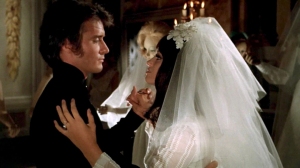 ‘How easily one is deceived by appearances.’
‘How easily one is deceived by appearances.’
A handsome young man who runs a bridal fashion house is secretly a serial killer, targeting young girls about to be married. Each killing brings him closer to unlocking a hidden memory from his childhood past, but the forces of law and order are closing in…
Somewhat hard to classify Giallo drama from legendary horror maestro Mario Bava that came out hard on the heels of Dario Argento’s ‘The Bird with the Crystal Plumage’ (1969) in the early months of 1970. Argento’s film redefined the Giallo and established many of the conventions followed by the sub-genre, and provoked the craze which saw dozens of such pictures produced in the first half of the next decade. Bava’s picture helped reinforce some of these specific elements.
Good looking young man about town John Harrington (Stephen Forsyth) has all the trappings of an ideal life. He’s head of a successful fashion business lives in a palatial house and drives an expensive car. However, behind the scenes, things are not so perfect. His marriage to the rich Mildred (Laura Betti) is in trouble, and she refuses to give him a divorce, reminding him that, although he may have inherited the fashion house from his mother, she’s the one paying all the bills. Being surrounded by beautiful models may provide plenty of opportunity for a bit of extra-curricular activity, but, instead, his taste runs to carving up prospective young brides with a cleaver. As he explains rather smugly in his voiceover, he’s completely mad.
Unsurprisingly, he’s a person of interest to Inspector Russell (Jesús Puente), especially after one of his models, Alice Norton (Femi Benussi) goes missing. She’s ended up in his greenhouse incinerator after a quick spin with him around the dancefloor of his private backroom. This is populated by mannequins in bridal gowns, which we quickly learn is the trigger that provokes Forsyth’s homicidal rages. Each murder provokes more memories of an event from his past, an event that he is desperate to recall, believing that this knowledge will free him of his madness.
This is a rather unusual entry in the ranks of Giallo, with some commentators considering that its inclusion in the sub-genre isn’t a valid one. After all, the only mystery in the film concerns the killer’s motivation, not his identity, and the climactic revelations when Forsyth regains his memories are hardly a surprise to experienced viewers. However, the notion of repressed childhood trauma as motivation for a killer did become a Giallo staple. Argento’s movie had touched on the idea, as had the Frederick Brown novel that was its initial inspiration, but it was Bava’s film that brought it front and centre. Of course, roots of this idea go back even further, to film noir such as Hitchcock’s ‘Spellbound’ (1945) and psychodramas like ‘The Spiral Staircase’ (1946).
The oddest inclusion in the film is the element of the supernatural. Not surprisingly, nagging wife Betti ends up on the wrong end of Forsyth’s macabre hobby, but it’s not the last he sees of her. Instead, she pops up frequently, at first seen only by other people, then only visible to him. This was apparently an addition to the script made by Bava after close friend Betti expressed an interest in appearing in the picture. Yes, her ghostly presence can be interpreted as a sign of Forsyth’s unravelling psyche as he nears total recall, but it sits uneasily in the narrative, especially at first viewing. It helps that Betti is terrific, and her scenes with Forsyth are some of the best in the picture, but it still takes some getting used to.
As a Spanish-Italian co-production, for once Bava was persuaded to work outside his beloved homeland, and the primary location used for Forsyth’s home was a mansion once owned by General Franco. Of course, Bava took full advantage of these high-ceilinged, rich interiors, and displays his superb technique with camera movement and shot framing. Despite the affluence on prominent display, it’s an unsettling, haunted place filled with threatening shadows.
If it had taken Argento’s debut film to popularise the Giallo, it was Bava who had birthed it, with earlier films ‘The Girl Who Knew Too Much’ (1963) and ‘Blood and Black Lace’ (1964). The latter film was also set in a fashion house and, as perhaps as an in-joke, actor Luciano Pigazzi turns up for a brief appearance in this film, playing much the same role as he did in the earlier one. The selection of such a business also plays into the director’s undoubted obsession with the unreliability of appearances. Here, he’s ably assisted by Forsyth’s performance, flipping from handsome and bland in everyday life to manic and violent after the sun goes down. Apart from Betti, none of the rest of the cast gets much of a look-in, unfortunately. However, the scene where she is bleeding out on the stairs above the heads of the oblivious Puente and his sergeant is superbly played by all.
As per usual, it’s Bava’s startling technique that engages, whether it’s the startling transition from a murder to a seance or the misdirection of following the initial murder on a train to Forsyth playing with a model locomotive, it’s a constant delight. Better still, these flourishes are included not for the sake of mere cleverness, but, because they inform the story and its characters. Forsyth’s perfectly preserved childhood room where his movements throw a shadowplay of light and darkness across the faces of his old toys is a perfect metaphor for his character’s inability to move on from the hidden trauma rooted deep in his childhood. Similarly, the scene where he caresses the mannequins in their wedding clothes is more than enough to inform us that, despite his playboy appearance and seeming lifestyle, there’s probably more than a little lacking in his bedroom activities.
This was Forsyth’s final film in a short film career based almost entirely in Italian and Spanish productions, including the lead in ‘Fury in Marrakesh’ (1966). He also worked as a photo-journalist during this period and found later success as a composer and choreographer. Some of his photographic work has a permanent place in the collections of New York’s Museum of Modern Art, and the Harvard Film Archives as well as several other prestigious institutions.
Leading lady Dagmar Lassander is given far too little do in the film, but went onto to lead Gialli such as ‘The Forbidden Photos of a Lady Above Suspicion/Le foto proibite di una signora per bene (1970), ‘The Iguana with the Tongue of Fire’ (1971) and ‘Reflections in Black/Il vizio ha le calze nere’ (1975). She had leading roles in many pictures during the following decade, including comedies and crime thrillers, as well as somewhat notorious horror ‘Werewolf Woman’ (1976). Later work included featured supporting roles in Lucio Fulci’s controversial horrors ‘The House By The Cemetery’ (1981) and ‘The Black Cat’ (1981).
Not one of Bava’s best, but still an absorbing psychodrama, touched by his usual genius.

It’s an interesting film, a hybrid of genres with a low-key finale. I wrote about the movie in a Monster Kid forum post. The opening scene and voiceover is like the closing scene of Tony Perkins in Psycho. As usual in most Euro thrillers, the police are ineffectual.
This film was completed in Barcelona in 1968, embryonic Giallo like BLOOD AND BLACK LACE, and for once Bava enjoyed working out of his regular surroundings.